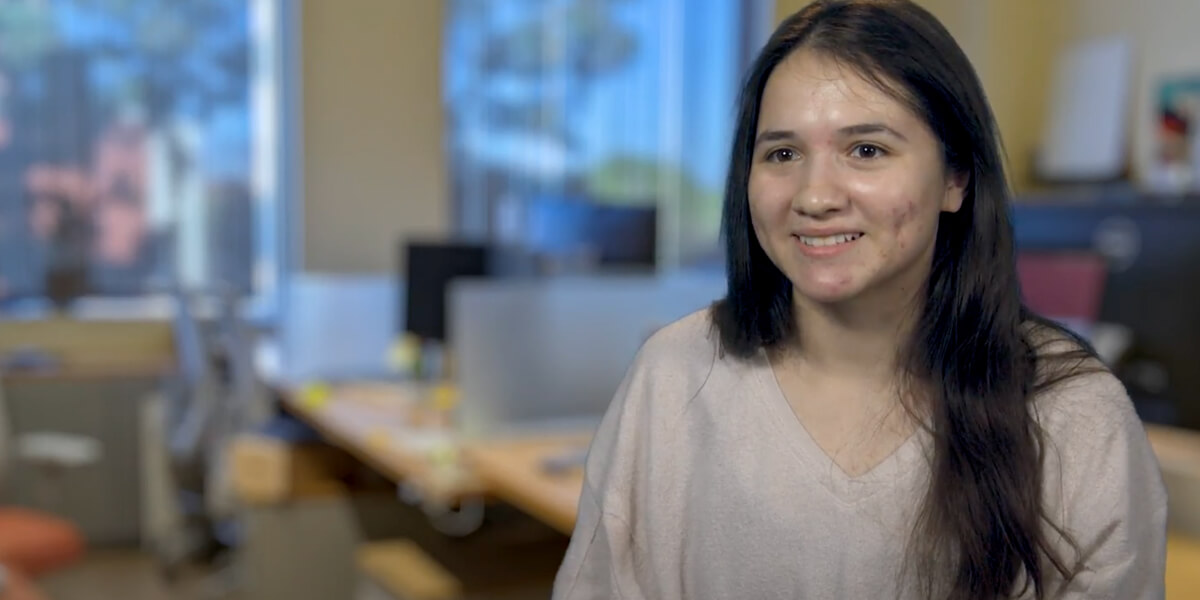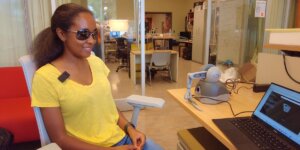
Cami Gomez’s project combines VR graphics with 3D printed models to simulate the feeling of pressing a button.
Sophomore Cami Gomez, like thousands of other students, had an unconventional first year at USC. Her freshman year was completely virtual. But that didn’t stop her from finding the hands-on engineering opportunity of her dreams.
“My freshman year was completely online, and I was worried I wouldn’t get to pursue any research opportunities,” Gomez said. “But I ended up finding a chance to develop my electrical and computer engineering skills through Professor Heather Culbertson’s HaRVI Lab.”
Through the HaRVI Lab, short for Haptics, Robotics, and Virtual Interaction Lab, Gomez worked on developing virtual button pressing. The project combined VR graphics with 3D printed models to simulate the feeling of pressing a button.
Gomez, an electrical and computer engineering major, spent 10 weeks working on the project remotely with help from a graduate student mentor, Sandeep Kollanur, a computer science Ph.D. student.
“Both Sandeep and Professor Culbertson were, and continue to be, amazing mentors to me,” said Gomez. “They’ve helped me through every step of the way with this project.”
Developing a mind for engineering
Gomez’s interest in computer engineering began far before her work on the HaRVI project. She traces this interest back to high school.
“My high school calculus teacher was the first person who pushed me to try engineering,” said Gomez. “She even gave me the number of an engineering alumnus to reach out to. I was uncertain at first, but I reached out to them. I became really interested in their work at the Facebook Virtual Reality Labs, so I interned there during my junior year of high school.”
Through this internship, Gomez met a variety of mentors who helped cultivate her passion for engineering. As she continued to follow this interest, Gomez realized how her other interests factored into engineering.
“I feel like I have a broad variety of interests. For instance, I love visual arts and music, two things that are often considered very different from engineering,” Gomez elaborated. “But, I’ve learned that engineering requires a creative mind. Engineering is about building solutions to problems, and my experience with creative fields has helped me with problem-solving.”
“Engineering is about building solutions to problems, and my experience with creative fields has helped me with problem-solving.” Cami Gomez.
Learning something new
As she gained more experience with engineering, Gomez followed this interest into college. She joined USC as a freshman in electrical and computer engineering major in 2020. Gomez began her work on the virtual button-pushing project the summer after, through USC’s Robotics and Autonomous Systems (REU) program.
Gomez expressed interest in working on this project due to the hands-on nature of its testing and applications. Haptics, the science of transmitting and understanding information through touch, is the foundation of this project. Virtual button-pushing involves tactile objects as much as it involves VR.
“I hadn’t worked with haptics before, so this seemed like a great opportunity to learn something new,” said Gomez. “And, once I began learning more about haptics, I realized how interested I was in it.”
Simulating a button clicking
The project itself is two interactive devices worn on users’ hands. The user’s left hand presses the virtual button, and the button “click” is simulated on the user’s right hand. The left-hand device is called a Leap Motion controller.
Most VR devices, such as the Oculus Quest 2 and the Sony Playstation VR headset, are typically worn on one’s face. However, Gomez describes the Leap Motion controller as “a pair of VR goggles for your hands.”
On their right hand, the user wears a device containing an actuator and an amplifier. When the Leap Motion controller detects a virtual button press, the actuator moves on the right-hand device. This simulates a button clicking.

Cami Gomez’s work focuses on VR and haptics tools and techniques.
During the duration of the REU program, Gomez primarily used items available around her house to create the system. However, with the help of Kollanur and Professor Culbertson, she started rebuilding the project in-person during the Fall 2021 semester.
“The end of the project was also kind of the beginning of the project,” said Gomez. “My goal for the summer was to have the device detect a button press and simulate a click. I was able to accomplish that goal. Now, the plan is to improve this system.”
She’s also been considering how to expand this project beyond button-pushing. Moving sliders, turning rotary knobs, and clicking other kinds of buttons all have unique sensations. By 3D printing models of these objects and interacting with them, the team is determining how to virtually replicate these sensations.
Experience the world tactically
Currently, VR is primarily used in the video game industry, since headsets give gamers a far more immersive gaming experience than TVs or computer screens. However, Gomez envisions VR having applications in the medical field, too.
“VR can allow people to interact with objects they normally wouldn’t be able to see or touch in person,” Gomez says. “As VR technologies advance, virtual environments with 3d printed, interactive objects within them become increasingly realistic. This can be leveraged to give hospitalized patients a chance to experience the world tactically. That’s what I hope this project will lay the foundation for.”
Published on July 5th, 2022
Last updated on July 5th, 2022











